This is part of the #STL2039 Action Plan storytelling series in partnership with Humans of St. Louis.
Rachel D’Souza Siebert: You featured my neighbor’s kids. I had said at one point, “I want to be a Human of St. Louis. When do I get to do this?” And Charli and David were like, “Just, go raise some money.” And I was like, “Okay.”
David Martineau: My son and I were grubby walking back from the library when we got approached to do it. I let him decide and he was like, “Yeah, we’ll do it.”
Rachel: I think we have a cute story.
David: We met through St. Louis Language Immersion School (SLLIS) because Rachel was working there when my son started kindergarten there in 2012. She learned that I worked at the National Conference for Community and Justice (NCCJ) and Rachel had been through Anytown, one of our programs.
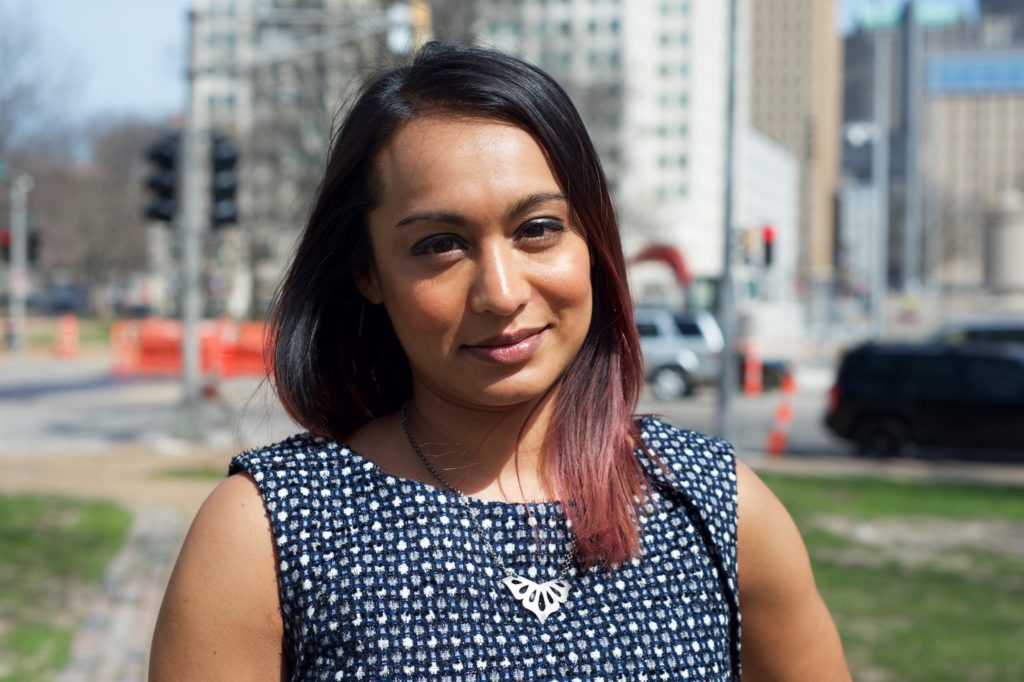
Rachel: I grew up in St. Louis and went to Nerinx. They had a really good relationship with NCCJ and the former program director. So I went through the Anytown program in 1999. I was already leaning towards social justice and that program cemented it for me for good. It’s flowing in my veins now. I shared this with David early on. My parents immigrated here from India, and my brothers and I were raised in a pretty much all-White community speaking English, going to Catholic school, all that stuff.
In Anytown, you spend a day and a half talking about systemic racism. So I’m in a big group of like 60 high school kids and we’re ready and don’t know what’s coming. And they asked us to split into groups of White students and people of color. There was myself and another girl who identified as Indian American. And we both just stood there because all of our White friends went in one direction, all of the Black kids went another direction, and we had both been very rooted in these White communities. We were like, “Wait a minute. Where do we go?” I was 17 years old thinking, “This is who I know over here. I don’t know this over there. I’m Brown. So, like, I’m supposed to go this way.” It was baffling. And mind-blowing. And it seems really silly, but it was the first time I actually realized what it means to be the other “other” in St. Louis. The conversation is so often Black and White that you almost have to fight for a seat at the table to even have a voice when you’re neither one of those identities.
The conversation is so often Black and White that you almost have to fight for a seat at the table to even have a voice when you’re neither one of those identities.
So when we met, I was the Director of Development at SLLIS and it was through getting to know David as a parent at the school, and a donor, and a volunteer, that I connected all of these experiences to each other. A few years later, I had my daughter and lots of stuff changed in my life with the founder of the school moving on and my husband taking on a new job. So I started to consult more to not get stir crazy on maternity leave. And I thought I would take six months of getting used to being a mom of two and then find a new job. That lasted for like seven weeks. And in the middle of the summer in 2015, I wound up back at SLLIS saying, “Hey, can I help you with some projects?” And then went to my son’s school, City Garden Montessori, and asked, “Can I help you with some projects?” And David reached out to me like, “Hey! What are you doing?” “I’m not sure what I’m doing right now, but I’m like consulting.” “Great! When can we meet?” So he’s actually one of my founding clients.
Was your company called Gladiator Consulting at that point?
Rachel: It was. There was this night in July when my husband was traveling, and I called my brother and said, “Come over! I have something fun for us to do.” So we drank wine and filled out this stuff and he was like, “Are you sure you want to call it that?” “Yes! I do.” So the legal name was Gladiator Consulting, but I didn’t know what I wanted to be public. So there was a six month period where I was RDS Consulting. I felt like that was very calm, but did not actually portray the passion the of the work the way I wanted it to. So I was like, “No, this is our legal name. We’re gonna do it.” I have been working with non-profit organizations since 2007, and I have preferred working with smaller organizations where you can see the needle moving and it sometimes feels like there are people in the work who are more connected to it and have focused on gathering the resources they need to be able to create the vision they want to create.
I don’t think I knew when I founded Gladiator Consulting how deeply affected and informed philanthropy is by racial and structural inequity.
I don’t think I knew when I founded Gladiator Consulting how deeply affected and informed philanthropy is by racial and structural inequity. Or how some of the racist systems I’ve seen in other aspects of my life impacted the work non-profits are trying to achieve in our community. It was through doing work with NCCJ, Arch City Defenders, and Forward Through Ferguson, and picking up some education-facing clients, that I realized with clarity this idea that St. Louis has a very generous community, but we’re generous in a way that makes us feel comfortable enough that we did something — not actually enough that we’ve changed our narrative. St. Louis has been voted the most generous community and every year there’s some announcement that comes out that we’re all expected to celebrate. There is this large transfer of resources that happens. But it’s happening more with our universities, our hospitals, and our cultural institutions – not with organizations who are leading and driving the change our community deeply needs.
David: Don’t forget the animals.
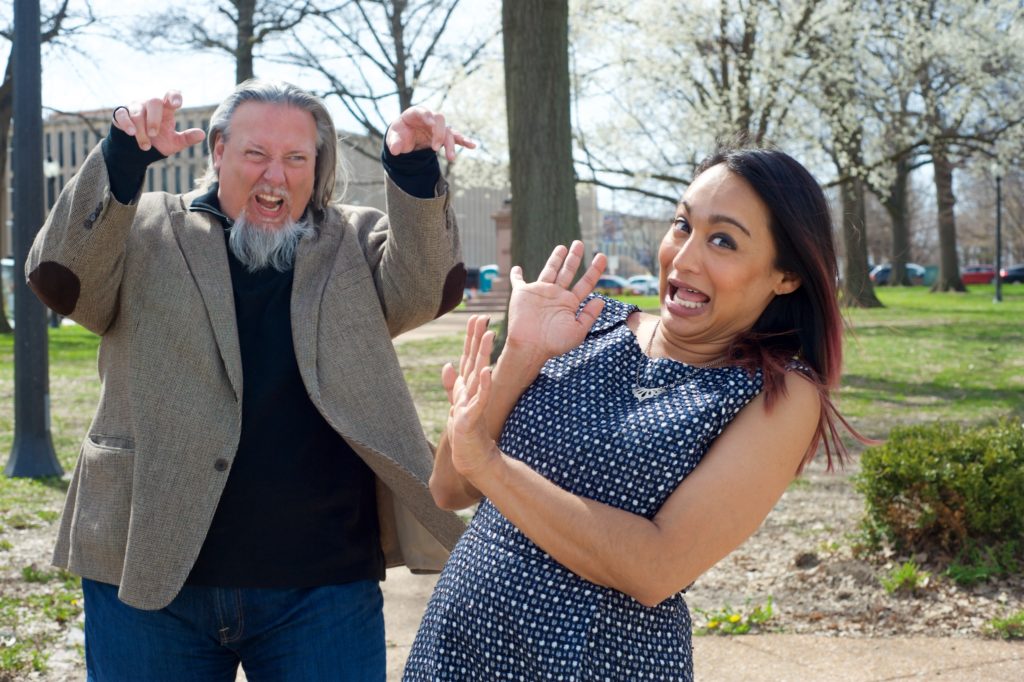
Dave Martineau and Rachel D’Souza Siebert. (Photostory by Lindy Drew/Humans of St. Louis)
Rachel: Oh, yes. I was including the zoo in that. You know, we talk all day long about how we want to have this world-class zoo and we want it to be able to serve such and such children in such and such radius. But then we have homeless children that are living in our community and there’s never been a cross-sector attempt to actually create an experience where these children can come and enjoy it. That feels ridiculous to me.
My sense is that people are just starting to dip their toes in the water of what it looks like to approach non-profit and philanthropic efforts with a Racial Equity lens. It’s super uncomfortable and hard. And a lot of people want quick wins and some easy stuff or they don’t like failure or things feeling hard. I don’t think I’d call the last three years of launching my consultancy a piece of cake. There have been struggles and failures and it is hard. But those small wins and incremental changes make the way I approach my work totally worth it.
David: That’s the point of the 2039 campaign. This type of work, systemic change work, is long-term. It’s generational. And from a development and philanthropy perspective, it doesn’t feel as good to invest in that because you can’t turn it around and put it in a report that makes it clearer. Like, “Oh, we finished this. This was completed. This is a very glossy, photo-ready outcome that we set out to create.” Instead, it’s a series of milestones or steps that move from inclusion to equity.
People are just starting to dip their toes in the water of what it looks like to approach non-profit work in philanthropy with a Racial Equity lens.
Rachel: NCCJ does an award ceremony celebration every year and last year it celebrated the 25th anniversary of Anytown. We invited five alums to come back and share their experiences and it was so interesting. There was a guy who was in one of the first Anytown’s, a White male – who, I think, was one of my counselors when I was there years later – and he talked about how that experience created this path for him as an educator. Like, “I decided one day I want social justice and equity to be involved in whatever I decide to do. Maybe I had wanted to be a doctor. Maybe I had wanted to be a lawyer. It didn’t really click in my head that this program was one of the reasons why my personal and professional life are all intersectional and work towards this hope of dismantling racial inequity in the community.”
Then there was a woman who was a year out of the program, getting ready to go to college, and she talked about how she thought she was going to do this thing because this is what the world expected her to do and now she understands that there are so many more opportunities for her and that she gets to choose and she can change her corner of the community. That is part of the story that doesn’t get told as often. Like, “Yes, the children talked about racism and sexism and ableism. Awesome. But what happens 10 or 25 years down the road?” To be having this STL 2039 conversation now, and thinking about that, when I’m going to be a grandma by then, what kind of community are my kids going to be raising their children in?
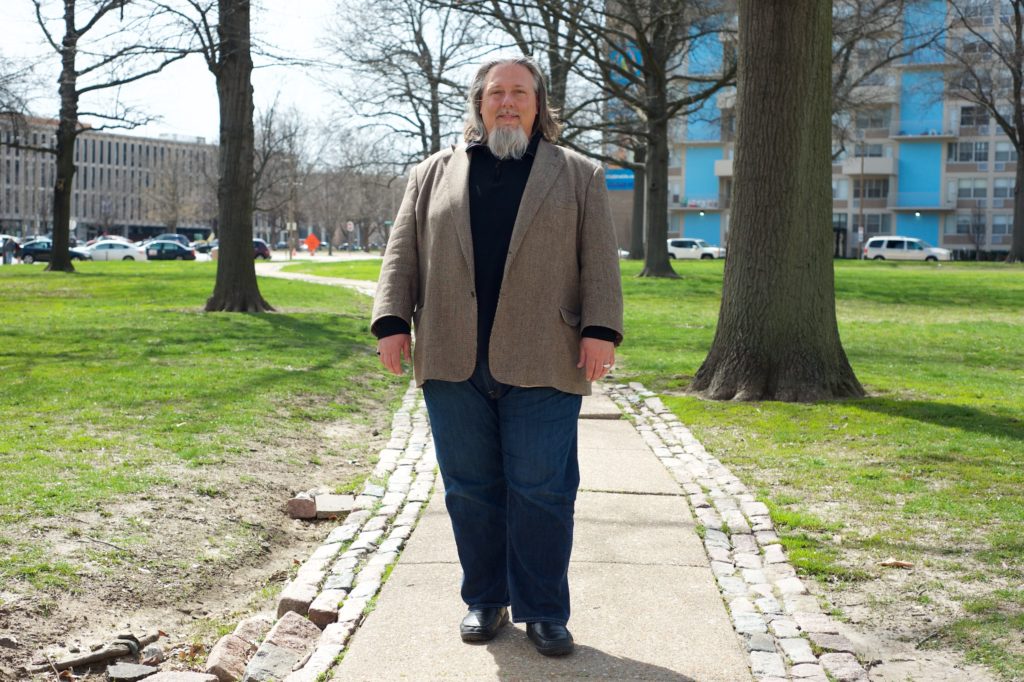
David: So NCCJ has been active here since 1930. We were founded as the National Conference for Christians and Jews. It was a national organization and we were the first regional office. And it was an interfaith to foster amity, cooperation, and mutual respect across religious identities. Over time, the folks who were involved began to realize that they shared more values than differences. That caused the organization to become involved in civil rights movements, anti-poverty movements, and other forms of justice; multiple identity-focused. So they became the National Conference for Community and Justice at some point nationally. And in 2005, the national office closed and we were one of 33 regional offices.
So we incorporated and became a local non-profit in order to continue bringing programs like Anytown and Dismantling Racism Institute – that were referred to at that time as, full immersion training – on these issues to the community. I moved here the same time the national was closing, and in 2009 I reached out to NCCJ for research purposes to learn about what sort of training programs they had because I was a student looking to do data collection. It turned out that they had an opening. I’d been really active with young people and in education, and I was hired in 2009 to adapt our work for the healthcare field. So having done intergroup dialogues and diversity inclusion trainings, I would meet somebody in the course of that work, over six or seven years, who would say, “Have you heard of NCCJ? Do you know Anytown in St. Louis?”
It was this recurring theme from people who had been part of the ripple effect of the programming that was happening, not just with NCCJ but with NCCJ St. Louis and what was happening here because the regional offices had some autonomy for how to approach the work that they did. And we were very rooted in doing this work looking at multiple identities, but that no matter which identity we were looking at, it was from an anti-oppression, deconstructing the systems that support it, humility kind of lens. And doing it in ways that motivated people and gave them the skills to figure out how they colluded with systems in their own everyday lives, which is really the magic of the way that we approached this programming.
People begin to see where they contribute to systems of oppression. So if we’re talking about race, we create systems where people who are in our training figure out where they’re colluding and how to either challenge it in new areas as an empowered member of a targeted racial group or to recognize where they need to challenge it as a privileged White person in relation to that kind of work. And with the dynamics, as Rachel alluded to in her early story, where are those dominant themes? In what ways does that play out? And where do they fit or where do they not fit in the ways that it’s standardly talked about? So having a border group, in addition to just the agent and target groups, having a group where people are figuring out, “Which parts of this in my lived experience apply, where doesn’t it apply, and what does that mean?” And then how do they meaningfully engage in this work is also an important component.
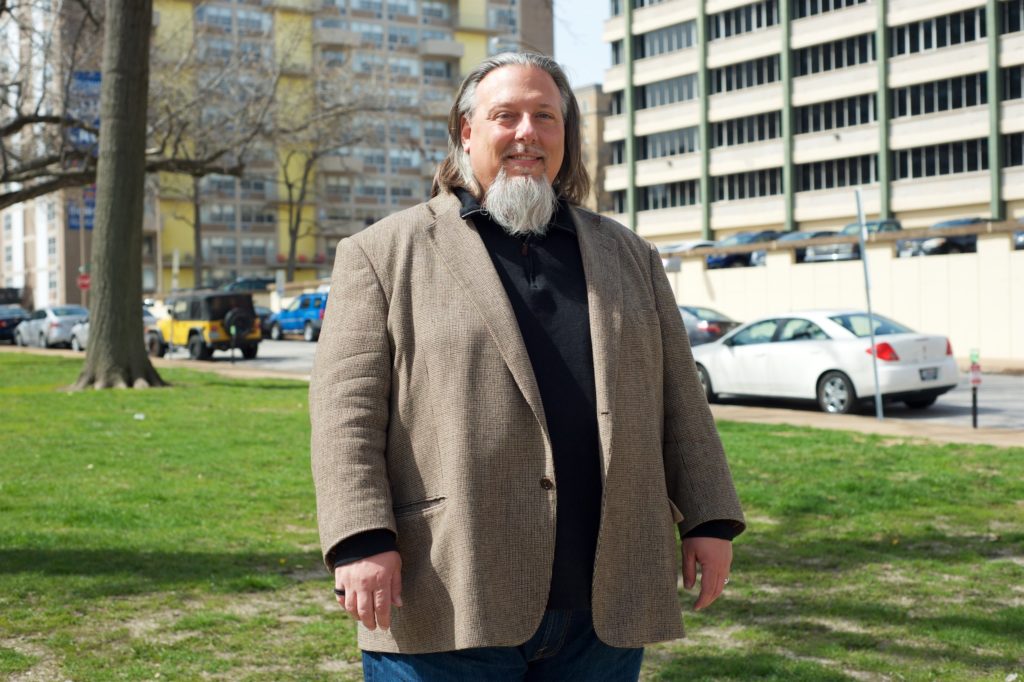
For me, personally, I went into an MSW program with the idea that I was working in youth development, youth services, and child welfare systems, and because of the over-representation of LGBT kids in foster and adoptive care, that was my focus. I took classes in Contemporary Cultures in the United States and Social Justice and Human Diversity, learned about all the identity groups, and it blew my mind open. And for the first time, in that course, as a social work student at 30 years old, I was confronted with being a White person, and being a male, and carrying privilege, whereas my focus had been on being working class and gay – areas where I was targeted. And that radically reshaped the way I understand the intersections of identity and what it means to be meaningfully involved in doing this work.
Sure I want to advocate for LGBT youth and I want gay rights, but those are tied up in a system that continues to advantage me, being White and being male, and I also need to be as vocal, if not more, as an ally in those areas. So coming out of my MSW program, my focus really shifted to figuring out how we change the systems that are running not just child welfare, but other areas that impact people based on any of these identities so that our school systems and the child welfare system and the criminal justice system and all of these areas that are set up in ways that disadvantage target group folks need to be open to systemic change.
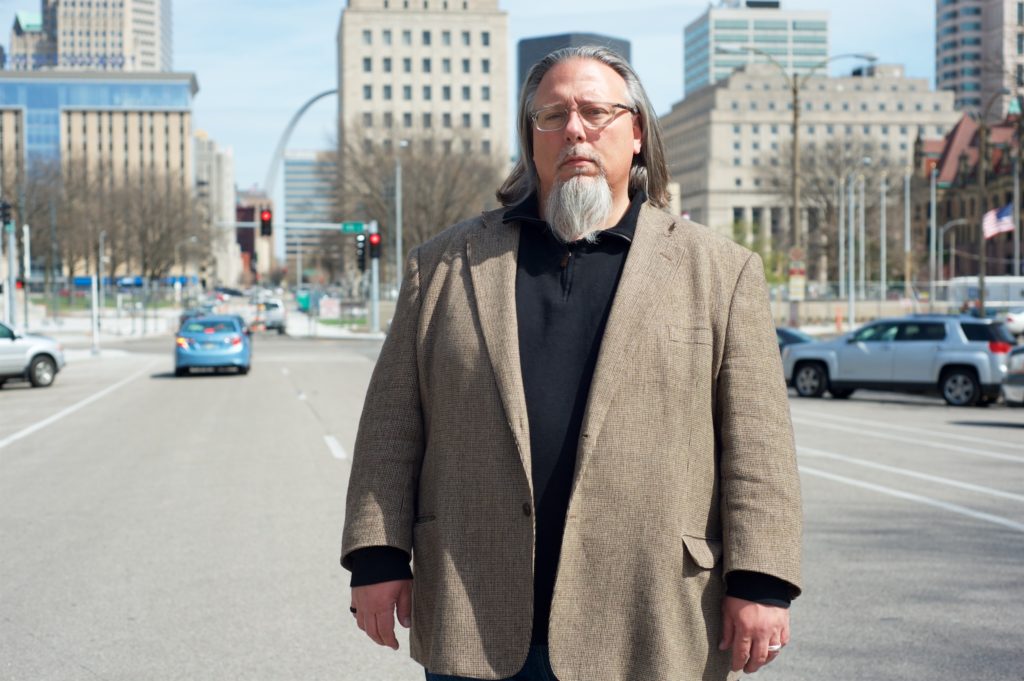
Then I became a foster adoptive parent. And there’s this peculiar thing if you’re going through the child welfare system to foster or adopt because you get to choose kids you will take and kids who you won’t take. You get to discriminate. And that’s good because if people realize that they really shouldn’t work with a certain group of kids, I don’t think they should have those children in their homes. But there’s also a lot of people who go into that not knowing what they don’t know. And wanting to believe that they see people as people, like, “Purple, pink, yellow, or green – whatever color they are!” And that’s not going to do good for kids who really need strong support. So we figured we would be open and that would mean a strong commitment to constantly reflect on the role race is playing in our lives as a family. That meant making sure we’re personally committed to it and not just professionally committed to it because of the line of work I’m doing.
So adopting an African American boy, in the context of St. Louis, there are questions about, “What high school did you go to?” and underlying racism and classism embedded in that. And the issues around Michael Brown and police brutality and criminal justice and driving while Black and getting pulled over — all of these things were professionally important to me and now they have a more personal importance in a way that could potentially impact my son. That’s motivating for thinking about how we impact those systems. He’s 11 already and 2039 is 21 more years away. He’ll be in his 30s by then. What could St. Louis look like? What could Racial Equity look like? And what benefits would that have for him? He has a class privilege that comes from being raised by two White, gay dads who are middle class and professional and can provide him a lot. But those only go so far.
I could advocate for my kid or I could advocate for African American kids, city kids, and all of the kids to be getting the kind of education they needed.
No matter what school he goes to, we have to be ever vigilant. First and foremost was recognizing that. For example, there were lots of issues that we experienced at a charter school, that was basically a startup trying to figure out how to do things, and doing them in an under-resourced way – even though Rachel was doing a kick-ass job and exceeding all of her goals with fundraising there. And we don’t fund schools in ways that are appropriate to counter the systemic injustice embedded in it. One of the things I noticed quickly in my son’s kindergarten was how race was operating. And I had a choice to make. I could advocate for my kid or I could advocate for African American kids, city kids, and all of the kids to be getting the kind of education they needed. One of those was much harder to do than the other.
And I was able, as a White person, to go in and be seen in order to have not just a meeting, but a lunch meeting or a coffee meeting or a Sunday morning breakfast meeting with leadership in order to discuss the things I was seeing and then give voice to things in ways that other people couldn’t. People of color would run the gauntlet trying to make that sort of thing happen, whereas I can literally go sit in the administrative suite, tell people I’m waiting until someone will see me, and not have that be seen as potentially problematic behavior. So that was the decision point to not make sure that just my kid wasn’t treated unfairly. Otherwise, that would have been colluding with the system and using my privilege for my own instead of trying to change the system. Changing the system is much more tiring, but nobody said that this work was going to be easy.
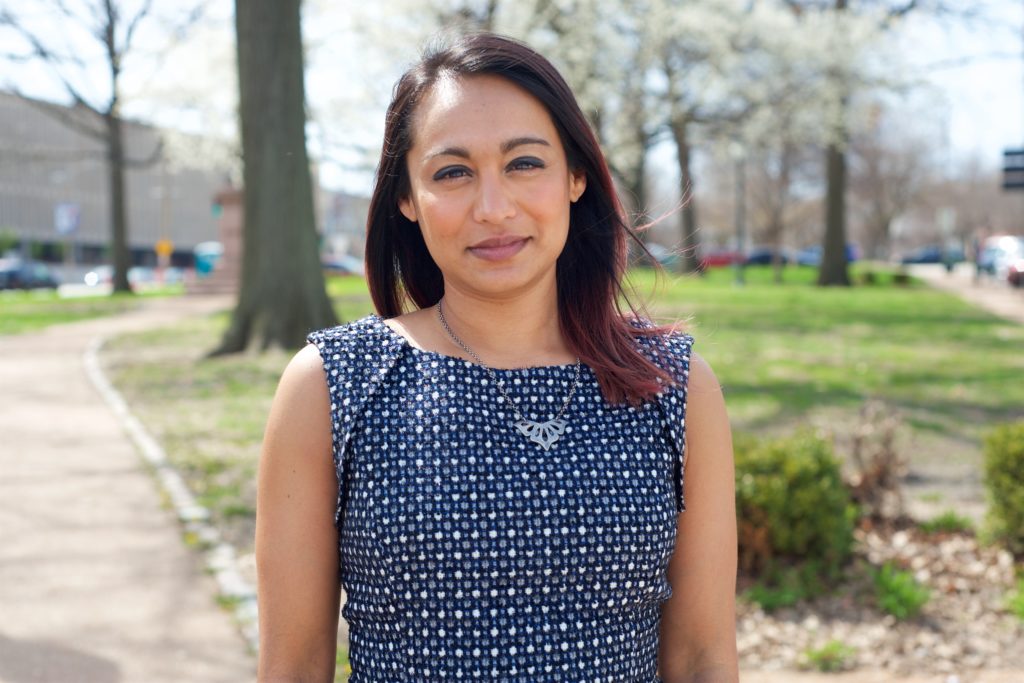
Rachel: You’re stirring up all this stuff for me, because this ‘not Black and not White piece’ comes up for my children often, actually from other children asking, “What color are you?” So my son will come home and he’s like, “Well, in the winter, I’m pink. But then in the spring, I get tan. But then in the summer. I get Brown. So I think I’m like three colors. And so is my sister. But Mommy is Brown. And sometimes dark Brown. But daddy is always pink.” Like, these very physical features. And they want to know what color I am, but I’m all these colors and I don’t know how to answer that question.
My husband is White and one of the biggest conversations of our relationship was where we were going to live and where we were going to send our kids to school. I did private school and he did public school in the county. When we met, we were both living in the city, and three or four years into our relationship, it was time to buy a house together. One of the perspectives I brought to the conversation was, “We have the resources and the privilege to live where we want. We could go live in the county. We could live in another city surrounding the suburbs. Who’s going to benefit from that? I want to create a community where my child is benefiting from being around kids that are or are not like him, and those children are benefiting from being around my child.”
Also, to this issue of what urban is, and what behavior is, and what kind of coded language parents use to talk about classroom discipline and things like that. We’ve had White families ask us questions about if we’re going to keep our son at that school. “Why wouldn’t I?” “Oh, well, you heard about this and you heard about that?” “I did hear about those things. And my son came home, and he asked me questions about what was happening in the classroom, and we talked about it, and I checked in with his teacher, and he’s learning, and he’s fine, and he’s having good relationships. So, no, I’m not moving my child because of some other parent’s fear about what might or might not happen with their children being around people that are different from them.” I’m not doing that. And, apparently, that makes you a crazy parent to decide to put your child in a situation that you think is amazing but another parent doesn’t.
It was funny because I asked, “What happened today?” And my son said, “Oh, so and so was having a really hard time with this activity. So I took him some colored pencils so he could quietly in the corner. Then went back to my puzzle.” Like, “Great. You saw another child in trauma, you helped him, and then you went back to do your work.” He didn’t see his mom freak out and pull him out of school get him whipped up about a child who probably had a bad start to their day.
David: We were talking about free-range parenting a little bit earlier and how there’s been a shift in terms of what it means to parent and the helicopter parent thing and the kids being constantly programmed sort of thing. And I didn’t do camps. I didn’t do aftercare. I came home on a bus and I was free until dinner. That’s changed a lot over time. When I’m with other parents, 90 percent of the time we’re talking about kids’ activities, camps, schools, and it’s all this very focused conversation on the conscientious cultivation of our children. It’s very class-based, and all kinds of intersections play in here.
Suddenly, all everybody talked about was where you’re going to send your kids to school.
So what that means is, I remember clearly when my son turned four, we were living in University City, there were a bunch of other kids in our neighborhood, and our block was really close. We had block parties all the time. But, suddenly, all everybody talked about was where you’re going to send your kids to school. We were the anomaly. The other White parents of White children were primarily talking about moving to the county. Like, further west. They were already in the county. The families who were Catholic and choosing parochial schools were staying because Christ the King was in the neighborhood. And then we were the only people planning to move to the city in order to go to a charter school to be eligible for SLLIS and be part of the language immersion piece.
The oneness of a mindset was amazing:“Well, we can’t stay here unless we’re going to do private school.” Like, “Okay…” I’m just mindful of how much time and energy as a person who is a parent, often hanging out with other parents, puts into conversations and planning around – to be really critical and explicit about it – segregating our kids. Like, how we’re going to participate in the structure so that we don’t have to face those difficult challenges or realities. And that’s something my partner and I don’t shy away from. Because our son’s in fifth grade, now we’re having explicit conversations with him about those decisions and about what those sorts of things mean.
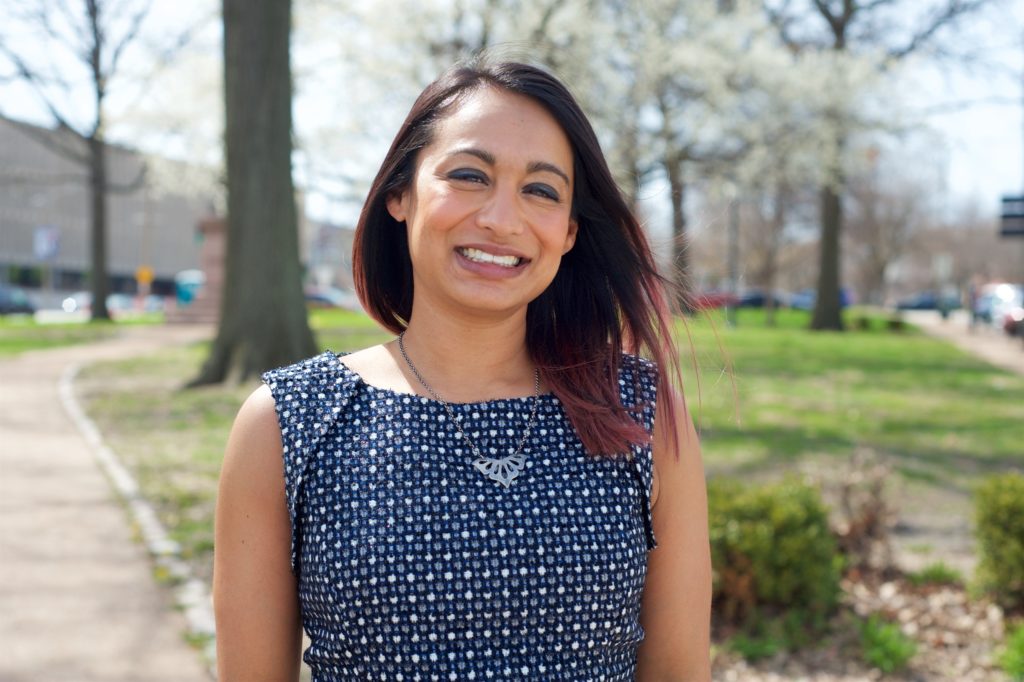
Is it really hard to turn off the work side of you when it’s connected to social justice and Racial Equity?
Rachel: My son got a fish for his birthday. He named the fish Rainbow, and he was talking aloud wondering, “Is the fish a boy or a girl?” My parents have the kids on Monday, so my parents were there, my daughter’s in the room, my husband was in the kitchen, and I just turned around, like, “The fish doesn’t need a gender identity. Rainbow could be a girl or boy.” And my mom, my dad, and my husband all look at me like, “Really?” And my son said, “But is the fish a boy or girl?!” I was like, “Oh, you can just make that decision.” Literally, I was just drinking my coffee and scrolling through Twitter, looking at the news, like, “Don’t worry about the fish! The fish is just fine.” So, no, it doesn’t turn off. I bring so much of who I am personally to this work and I wouldn’t be good at my job if I didn’t. I feel really clear about that.
When David and I started working together, I still had an infant with me and had made it clear to him and other clients that, “I think my brain still works with the child in the room, but I want you to be comfortable.” And if you are going to walk the talk of equity work, then you create different ways for people to get work done. So we had this relationship where my children would be with me. There was one time when David brought his son with him. And we did the work we needed to do with respect for who each of us are as parents with all the identities that we bring to this work, knowing that the way that we do the work can look different and potentially yield better outcomes versus trying to fit this outside of the box work into a box that actually hasn’t done much for anyone for a long time, except for White cisgender men. And to dip my toes in that water and say, “Oh, I can be a whole person in my work,” was the green light to go for it. Like, “If I fail now, I know that I’ve failed as authentically as I possibly could.”
But we’ve been doing this together for three years and have gotten to see some really exciting things happen. David was pulling the organization out of a fairly precarious financial reality when we started working together. And then got to the end last year with a surplus!
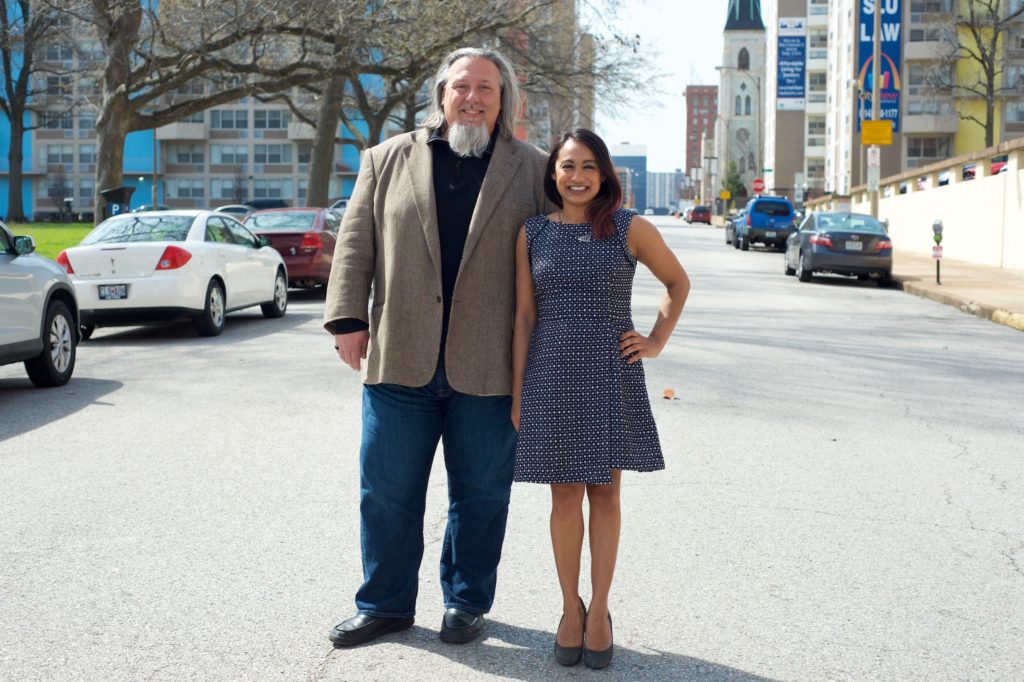
David: What? What is that?!
Rachel: I mean, not that a non-profit’s cash flow problems ever ends. But, heyyy!
David: Yeah, we’re in a radically different place. And, turning it off? No, it doesn’t turn off. My son is at New City School, which actually does a fantastic job around inclusion and equity, and it’s really helpful. He moved there in fourth grade and I remember asking him, “What are you talking about in school today? What did you learn?” “Today we learned about person-first language. Do you know what that is?” It was like, “You know person-first language in fourth grade?” That’s amazing. I didn’t learn it until my MSW program. So I love that he’s now in a space where he is also getting that kind of education or reinforcement. We still do it and wanting to be part of those conversations, but he’s also getting it elsewhere.
And that enables me because it’s almost simultaneous with me switching into this new role here from doing the programs to now supporting a team in an organization with and network of board members and volunteers. Leading them in this work is a whole different skill set and has required a lot more energy, and focus, and on-the-job learning for stuff that I haven’t previously done. So it’s helpful to have a team with Rachel and our staff who are thinking about these things and providing support in moving forward. And to have a school where I’m not having to do the heavy lifting of engaging my son on these conversations because I’m not solely homeschooling him on social justice issues. They can also step in and join him where he is.
So it was easier to lead a five-day program or a three-day retreat and create a set of norms around how we’re going to operate together. We’re building that container for the work. And it’s more difficult to do that in community meetings, and board meetings, and staff meetings, and writing grant proposals, and sponsorship requests. In our programs, we encounter the manifestations of racism, classism, sexism, etc. And we can jump on them and unpack them for learning and growth. But it’s harder to do that when you’re also trying to get money from a foundation, but now there’s this teachable moment. So I had to learn how to balance the mission of the work while also building the alliance, support, sponsorship, and funding so that we’re around to continue doing the work.
Rachel, how did you help facilitate that work for NCCJ?
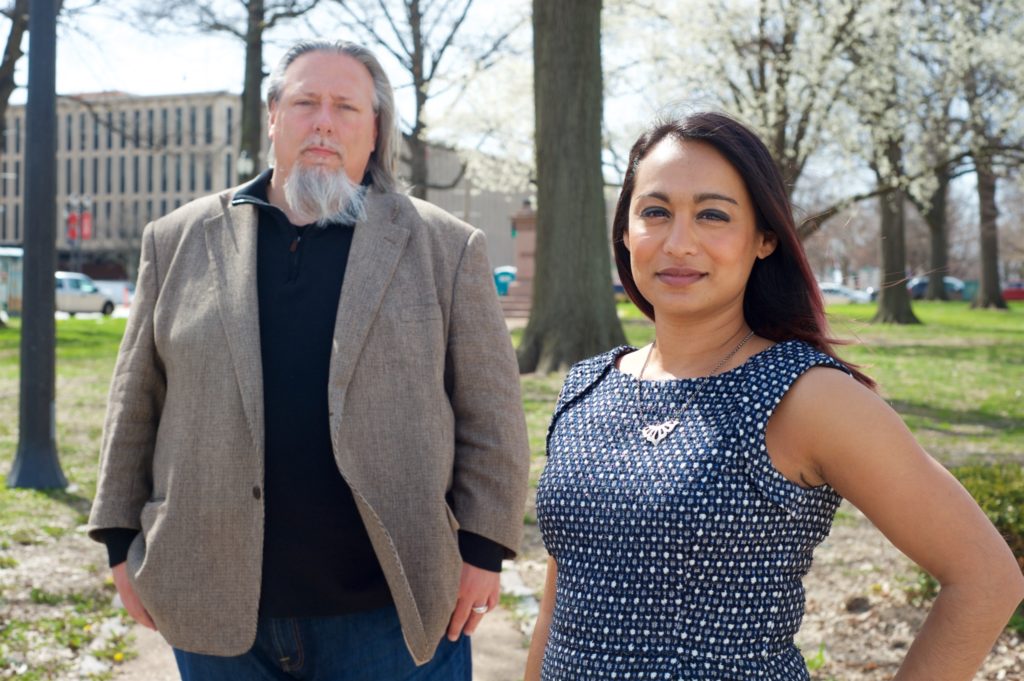
Rachel: Sometimes the blessing and the curse is that NCCJ had been around for a long time and they had a lot of relationships. They had a very well respected name across the community. The work that we really had to do in the beginning was to get clear on what exactly it was that we were trying to accomplish, reignite those relationships with people who had been longtime supporters, and then figure out how to connect with the youth that we’re serving.
I am a big believer that St. Louis has an abundance of resources and they feel scared because we use them poorly or we don’t know how to use them or we refuse to use them in concert with other organizations. So we talked about trying different things and we talked about doing some of the same things that worked really well. David and the other board volunteers who’ve been involved in development have been open to this idea that, “There’s more that can be done and we should try it. And if it works, we’ll keep doing it. And if it doesn’t work, maybe we’ll try something different.”
The notion that we’re all trying to do our work to the benefit of the people that are living, thriving, and existing in this community should be the guiding star for all of us.
And also this idea that, “Because we are an organization that offers educations and training, if you are a financial supporter of the work, you should experience what we’re offering.” NCCJ has really tried to get to a point where the organization is funded through fee-for-service programming and charitable donations. So when you have an organization be a sponsor for a dinner or sponsor student scholarships to Anytown, we create a space to have conversations about what their institution needs from us. And how do we start to build a broader platform for the education and the messages? And as much as we have an idea of what this work looks like and how systems can be dismantled, what is our community in need of now? And doing that in a way that doesn’t create or reinvent a new wheel, but figuring out how to partner with Forward Through Ferguson, Anti-Defamation League, Diversity Partner Awareness, or other consulting groups to compliment each other’s work.
From my non-profit perspective, trying to get people in a room to have a conversation with each other can be insanely frustrating. That could be because their boards don’t think it’s a good idea or someone had a bad experience once or because we don’t play in the sandbox or because our vision is this and their vision is that. And the notion that we’re all trying to do our work to the benefit of the people who are living, thriving, and existing in this community should be the guiding star for all of us. And that should be enough to put ego and assumptions aside. And if that were true, we’d be in a much different place.
Part of the conversation for me has been reframing what charitable relationships look like with funders. There’s this annualized idea of how we give money that has forced non-profits into this cycle so that we’re racing and scrimping and saving and moving things around. And we get to a point where they maybe have a couple of weeks to exhale. And then the year starts over again and they get to start this other thing. Organizations know to expect this type of cycle and donors expect to give at a certain point. So what does it look like to do this work differently? How do we create a system where we can do this work year-round?
The people supporting us know exactly how their funds are being invested, have made multi-year commitments or recurring monthly donations to the organization, and we know what to expect from them. And we actually are afforded the flexibility to plan for things and celebrate the things we don’t expect. For smaller non-profits, that’s a huge challenge that prevents mission success and achieving whatever their vision would be for the community.
There are people who don’t have Racial Equity in their vocabulary, but then there are people trying to move things in their institution or working towards funding to make something happen against the status quo. Where else does Racial Equity play a role in this conversation?

David: Two things come to mind. One, it’s hard to talk about this work because when people hear about what we’re doing at NCCJ, we’re filed in their minds as diversity trainers. That’s the big catch-all that we fall under. There’s been a migration to inclusion over diversity. Maybe it’s just because I’m more focused now on the Racial Equity component, or that idea of equity and the definition that Forward Through Ferguson uses in terms of outcomes, that it almost seems like there’s a doubling down on diversity and inclusion efforts. I don’t think it’s ill-intended people. The past five years, and the stuff that has been going on, it’s very high profile. Things like Michael Brown and so many incidences of clear racial disparities in policing and other things. Those make people feel like they need to do more, but then that’s often translated into doing more of what we already know how to do, which falls into the diversity and inclusion stuff.
So it feels like there’s so much more effort being made, like public forums and symposiums, and some of them aren’t taking a step toward thinking about equity. It’s just doing more of what we’ve done, but doing it in showier ways or in more public ways. I don’t want to knock that because, for some people, these terms are not even in their vocabulary. And there’s a continuum or a pathway, as Forward Through Ferguson defined, where we need to move people along. But there also needs to be some concentrated support and focus on what equity looks like, how that’s happening, and how that needs to happen differently. We used to just try to get people beyond the diversity multicultural potluck where everybody brings a dish to actually think about, “What are all of the ways that you need to build inclusion into the work of your organization?” That one event can be nice, but if you think you’ve done it there, people aren’t actually feeling welcome. They’re feeling tokenized. And that you want their pirogue or polish sausage. So that’s not enough. But now there’s this new not enough.
And the second point is that there needs to be financial support or recognition that helping people tackle equity and redesigning systems in order to promote equitable outcomes, that’s going to need resources, new skills, and new plans. And those are just going to be doubling down on what we’ve been doing. So we’re going to do diversity, inclusion, and equity, and then we need to be thinking about how to support folks from a philanthropic standpoint, from – what we focus on – an educational professional development standpoint, and then an organizational development or change standpoint to really help people change those systems.

Dave Martineau and Rachel D’Souza Siebert. (Photostory by Lindy Drew/Humans of St. Louis)
Rachel: I started to get into consulting with different organizations who are more involved in the social justice space in regards to their mission and vision. For the St. Louis community, Racial Equity tends to be the root cause for why or how such a system came to be that these organizations have to exist in order to dismantle and disrupt. And it felt unethical. It felt wrong to have organizations like Forward Through Ferguson and NCCJ then turn around and have to raise funds from people who are well-intentioned – because there’s not mal-intent for the most part in philanthropy – but whose charitable practices do perpetuate the status quo and give just enough money to do just enough work to keep things close to the same but maybe a little bit better. It doesn’t sit well with me.
So a lot of the principles we test and the ideas we work on are based on this community-centered philanthropy and fundraising for social change. There’s not a ton of resources out there that tell you how this work should go and what kind of outcomes to expect. And that feels a lot like this idea that none of us have ever been alive to see what Racial Equity looks like. But if you’re willing to be on the path together, you’ll get closer to what you’re trying to achieve.
Funders expect for non-profit work to be transformational, and that’s a two-way street.
I’ve been lucky to work with organizations who get the mid-term and the long-term, and are willing to try things that they haven’t tried or feel comfortable with the potential of saying no to funding if it really doesn’t align with what their mission and vision are. And that’s tricky. We do need money to keep the lights on have the doors open. But what’s the trade-off? And what do we perpetuate as an institution when we take a philanthropic contribution or build a collaborative partnership that actually isn’t in the best interest of the people that we’re trying to serve and the work that we’re trying to do?
So sometimes it’s exhausting because there are things you want to be really excited about, and then you learn about circumstances and situations, and you realize, “If we’re going to be true to equity and if we’re going to be audacious, then we have to say ‘no’ to some resources or we have to make demands of the person or the institution who wants to give us that resource that they have some skin in the game beyond cutting a check and asking for a report.” Funders expect for non-profit work to be transformational, and that’s a two-way street.
What does a Racially Equitable St. Louis look like to you in 2039?
David: I’d like to spend more time talking about Racial Equity and racial justice with other parents rather than talking about what schools our kids are going to go to and what camps they’re going to be enrolled in. What Racial Equity could look like is a system of educating our young people in which we didn’t have to approach a choice of school the same way that we would approach purchasing a product that has all the right features because we could trust that the schools we’ve built that are in our neighborhoods will provide our kids with the kind of education they deserve; the kind of education that will move them securely into the future. What that means is that we collectively – meaning, not by an overabundance of individual school districts each competing with one another; not to mention the parochial, private, independent, and the charter schools – recognize that the education of all of our children is all of our responsibility. And that we have the capacity to move beyond politics and scarcity of resources in education to figure out how to do that. Personally and professionally, my focus and thinking about these issues is so tied up in programming with schools and young people and as a parent with a child who’s 11. Fundamentally, education as liberation is really what it should be at it’s best. And all too often it’s not.
Rachel: We can also spend time down the path of how race is a social construct and we’re all worked up about something that actually isn’t real, but we’re not there yet. And that’s fine. So when I think about 2039, everybody in this region believes and shares the vision that Racial Equity is benefiting everyone. I think about things like intentionality, like, if David were to say, “When my time comes to move on to a new role, we need to get clear about what the next leader of the organization looks like. And how does the board get on board with the idea of potentially having a person of color or of a different identity?” And if you have a candidate pool of other White men or White women, what does it look like to create a space to source a candidate that needs to be the leader of this organization and be provided professional development opportunities to fill his shoes? What does it look like for the zoo to say, “For a year or for two years, we are only going to subside on the tax dollars that are allotted to us. And the $5,000,000 we raised annually, we’re going to put in this fund and we’re going to figure out homelessness in the City of St. Louis. Because if we really want to be a world-class institution, we really want the 25,000 children living in the city limits and however many children who live in the county to be able to come here and enjoy their time here. They need to be safe, they need to have stable housing, and they need to have a great school environment.” What does it mean for us to stop functioning in these silos and start thinking about the actual, bigger picture when we all win because everybody has equitable access to resources and opportunity?
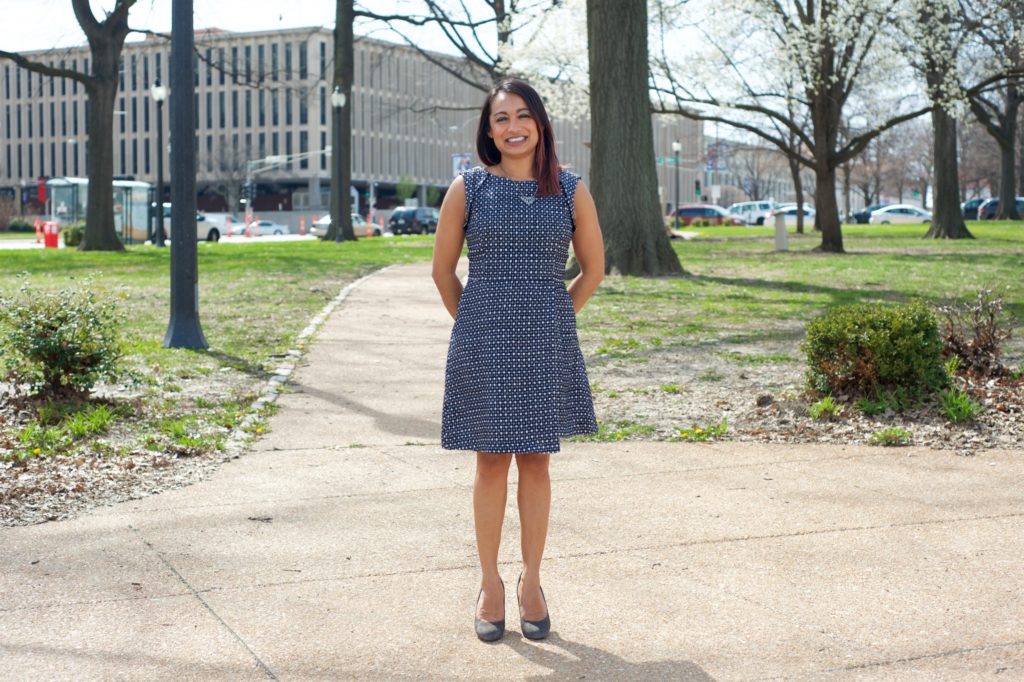
I think about my children and, when I was growing up, you didn’t move to the city to send your kids to school. When I started working at SLLIS in 2011, it was an anomaly to move to the city to send your children to school. And we still have a law that says that Black children living in the city can go to school in certain county districts. And I remember thinking, since we were also foster parents for a duration of time, if we live in the county, I’m going to wind up in a situation where my half White child could go to SLLIS if I wanted him to, but my foster adoptive Black child cannot because of a law that exists that was passed in 1982. So how do we write the other piece of this Racial Equity? How do we examine, at a policy level, all of the structures that have been put in place to keep the system thriving and be really intentional about changing the rules? I don’t mean to say that that’s going to happen through policymakers. Every person in this community has a role as a constituent in changing the policy narrative of the region. And that is a completely different part of the story. I was a political science major in college and I’m just now beginning to figure out where my role is in policy and in this conversation.
And then there are these little things, like, I would love to be with my children and not have somebody ask me what my husband is. And my husband would love to be with our children and not have somebody ask what his wife is at the grocery store that we go to all the time. I would love to not have my son come home from school and ask questions about if his Black friends are going to get hurt because their skin was Black. I didn’t even get to have Black friends growing up because of where I lived. My son has them and he’s worried about them? He’s seven. I don’t want that for my grandchildren or for whatever children are here at that point.
But, I do know I don’t want it to be 2039, and we have Racial Equity month. That is what I don’t want.
Dave Martineau
Former Executive Director, National Conference for Community and Justice
Rachel D’Souza Siebert
Founder, Gladiator Consulting

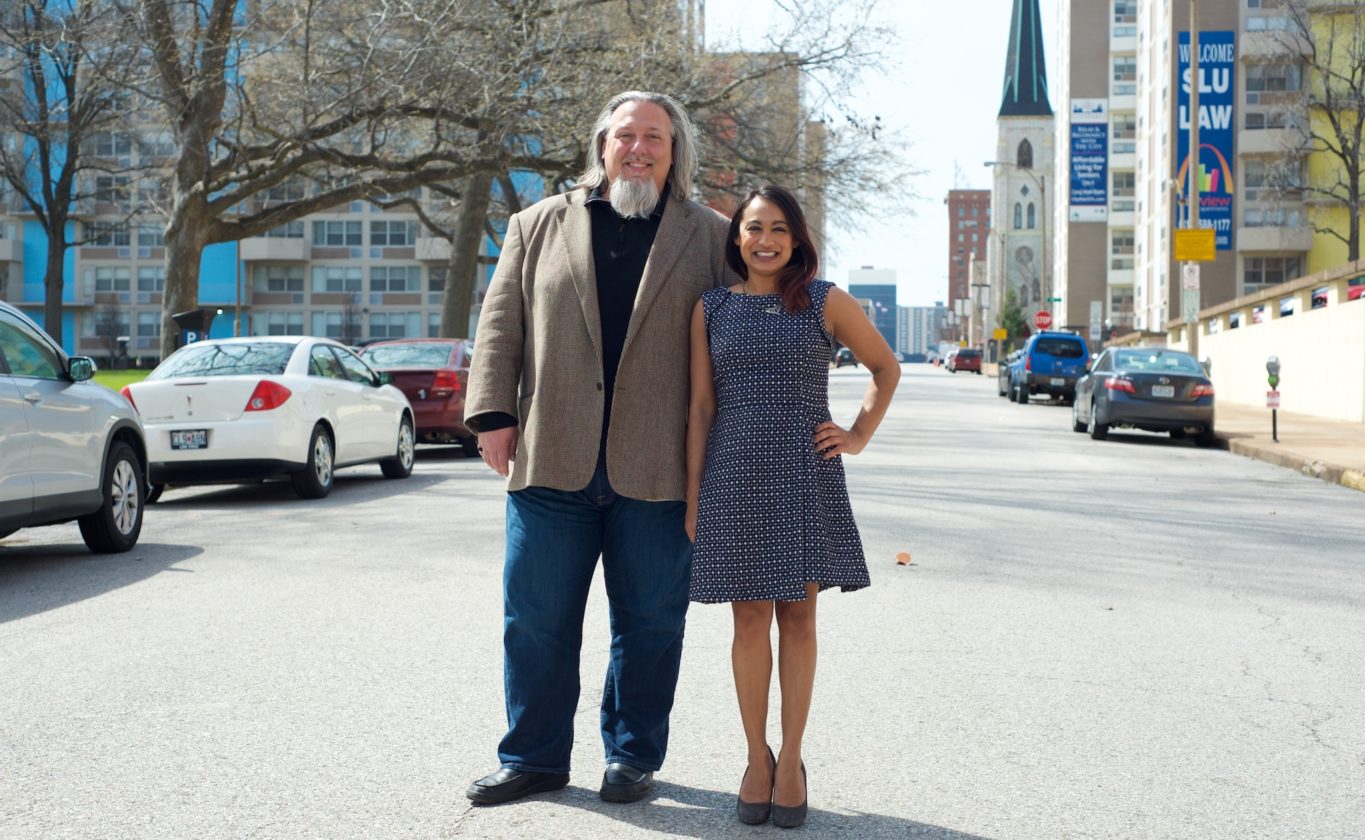
#FwdThruFerguson